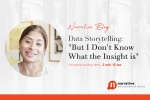If you have not read the introduction to this blog series, we recommend you read it here .
This blog is a part of 3 part blog series where we have learnt a sequence of analysis method used by radiologists and using that knowledge created a sequence of analysis method for data analysts.
In this blog post we cover how best to data story-tell when we our analysis is obvious to all.
Obvious to All Analysis
 |
|
 |
In this case it is important to note that as a data analyst you can present with the information you have on hand and establish the need for further analysis. The responsibility can be either given back to the sales division to find out or be brought up as a discussion point in the meeting to find out why the dress sold more or at-least come up with some hypothesis for further investigation. It is worth remembering that you can be presentation ready without actually finding out what caused the floral dress sales to increase. As a data analyst, it is not your sole responsibility to find out everything but it is your responsibility to point in the right direction and trigger further analysis to generate insights that can draw better business outcomes. In absence of the actual finding, directional data storytelling is very valuable. |
You can read part 2 of 3 : Obvious to some analysis
You can read part 3 of 3 : Obvious to none analysis
"I attended your story telling course some time back. And I've enjoyed keeping up my knowledge with your blog. You may not have realised however, that the Whole of Government is implementing Internet Seperation. Hence I'm not able to access the links to read your articles. Could I suggest including a QR code in your emails so that I can use my mobile to scan it and gain immediate access to the article? It would be most helpful"










